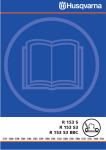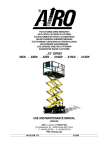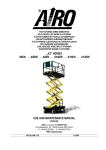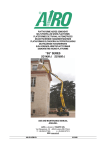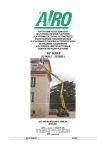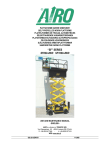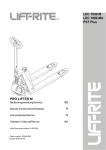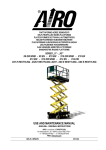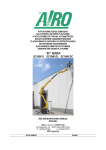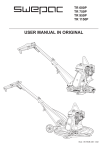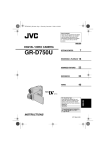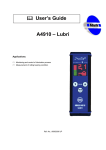Download required periodic inspections by the owner
Transcript
CARRELLO SEMOVENTE CON POSTO DI GUIDA ELEVABILE SELF-PROPELLED TRUCK WITH ELEVATING OPERATOR POSITION CHARIOT AUTOMOTEUR À POSTE DE CONDUITE ÉLEVABLE SELBSTFAHRENDER WAGEN MIT ANHEBBAREM FAHRPLATZ CARRETILLA AUTOPROPULSADA CON PUESTO DE CONDUCCIÓN ELEVABLE ZELFRIJDENDE WAGEN MET HEFFENDE BESTUURDERSPLAATS „MICRA“ SERIES MICRA290 USE AND MAINTENANCE MANUAL - ENGLISH AIRO is a division of TIGIEFFE SRL Via Villasuperiore , 82 -42045 Luzzara (RE) ITALIA' +39-0522-977365 7 +39-0522-977015 WEB: www.airo.it 042.20.UEM-EN 03-2008 Tigieffe thanks you for purchasing a product of its range, and invites you to read this manual. Here you can find all the necessary information for a correct use of the purchased machine; therefore, you are advised to follow the instructions carefully and to read the manual thoroughly. The manual should be kept in a suitable place where no damage can occur to it. The content of this manual may be modified without prior notice and further obligations in order to add changes and improvements to the units already delivered. No reproduction or translation may take place without the written permission of the owner. Contents: 1. INTRODUCTION.............................................................................................................................................................................4 1.1 Legal aspects ...........................................................................................................................................................................................4 1.1.1 Delivery of the unit ..............................................................................................................................................................................4 1.1.2 Periodical checks.............................................................................................................................................................................4 1.1.2.3 Transfers of Ownership ...............................................................................................................................................................4 1.2 Intended use.............................................................................................................................................................................................4 1.3 Description of the unit...............................................................................................................................................................................5 1.4 Control stations.........................................................................................................................................................................................5 1.5 Power supply ............................................................................................................................................................................................5 1.6 Identification .............................................................................................................................................................................................6 1.7 Location of main components...................................................................................................................................................................7 2. TECHNICAL FEATURES OF STANDARD MACHINES (DIMENSIONS AND PERFORMANCE) .................................................8 2.1 2.2 Dimensions...............................................................................................................................................................................................8 Performance.............................................................................................................................................................................................9 3. SAFETY PRECAUTIONS ..............................................................................................................................................................10 3.1 Power supply ................................................................................................................................................................................................10 3.2 Work and maintenance rules..................................................................................................................................................................10 3.3 Safety rules.............................................................................................................................................................................................11 3.3.1 General..........................................................................................................................................................................................11 3.3.2 Handling.........................................................................................................................................................................................11 3.3.3 Operating procedures....................................................................................................................................................................12 4. INSTALLATION AND PRELIMINARY CHECKS...........................................................................................................................13 4.1 Before using the machine.......................................................................................................................................................................13 5. GENERAL USE INSTRUCTIONS..................................................................................................................................................14 5.1 Operator position....................................................................................................................................................................................14 5.1.1 Drive and steering..........................................................................................................................................................................15 5.1.2 Operator position lowering / lifting .................................................................................................................................................16 5.1.3 Mobile loading surface lowering / lifting .........................................................................................................................................17 5.1.4 Other functions ..............................................................................................................................................................................17 5.1.4.1 Emergency STOP button (E).....................................................................................................................................................17 5.1.4.2 Battery indicator and hourmeter (L)...........................................................................................................................................18 5.2 Electric power unit ..................................................................................................................................................................................19 5.3 Access to operator position ....................................................................................................................................................................20 5.4 Start-up...................................................................................................................................................................................................20 5.5 Lifting and carrying loads........................................................................................................................................................................21 5.5.1 Mobile loading surface and ground loading space ........................................................................................................................21 5.5.2 Lifting and carrying loads on the mobile loading surface...............................................................................................................22 5.5.3 Carrying the loads on the ground loading space ...........................................................................................................................23 5.6 Machine stop ..........................................................................................................................................................................................24 5.6.1 Normal stop ...................................................................................................................................................................................24 5.6.2 Emergency stop.............................................................................................................................................................................24 5.7 Manual emergency lowering control.......................................................................................................................................................25 5.8 End of working session...........................................................................................................................................................................25 6. HANDLING AND CARRYING........................................................................................................................................................26 6.1 6.2 6.3 Handling .................................................................................................................................................................................................26 Carrying..................................................................................................................................................................................................26 Machine emergency removal .................................................................................................................................................................27 7. MAINTENANCE.............................................................................................................................................................................28 7.1 Machine cleaning....................................................................................................................................................................................28 7.2 General maintenance .............................................................................................................................................................................29 7.2.1 Various adjustments ......................................................................................................................................................................30 7.2.2 Greasing ........................................................................................................................................................................................31 7.2.3 Hydraulic circuit oil level check and change ..................................................................................................................................31 7.2.4 Hydraulic filter replacement ..........................................................................................................................................................32 Use and maintenance manual Self-propelled aerial platforms Page 2 7.2.5 Inclinometer operation check and adjustment ...............................................................................................................................32 7.2.6 Operation check and adjustment of overload controller ................................................................................................................33 7.2.7 Safety micro-switches operation check .........................................................................................................................................34 7.2.8 “Dead-man” switch operation check ..............................................................................................................................................34 7.2.10 Battery ...........................................................................................................................................................................................35 7.2.10.1 General warning instructions.....................................................................................................................................................35 7.2.10.2 Battery maintenance ................................................................................................................................................................35 7.2.10.3 Battery recharge........................................................................................................................................................................36 7.2.10.3.1 Battery charger: safety devices and fault reports..............................................................................................................37 7.2.10.4 Battery replacement ..................................................................................................................................................................37 8. MARKS AND CERTIFICATIONS .................................................................................................................................................38 9. CHECK REGISTER ......................................................................................................................................................................38 Use and maintenance manual Self-propelled aerial platforms Page 3 1. INTRODUCTION This Use and Maintenance Manual provides general instructions concerning the complete range of units indicated on the cover. Therefore the description of their components, as well as control and safety systems, may include parts not present on your unit since supplied on request or not available. In order to keep pace with the technical development AIRO-Tigieffe s.r.l. reserves the right to modify the product and/or the use and maintenance manual at any time without updating the units already delivered. 1.1 Legal aspects 1.1.1 Delivery of the unit Within EU (European Union) member countries the machine is delivered complete with: - Use and Maintenance manual in your language; - CE mark applied on the unit; - CE conformity declaration. Please remember that the Use and Maintenance Manual is an integral part of the machine and a copy of this, together with copies of the documents certifying that the periodical checks have been carried out, should be available to the operator. In the event of a transfer of property the machine must always be provided with its use and maintenance manual. 1.1.2 Periodical checks The legal obligations of the owner of the machine vary according to the country of commissioning. It is therefore recommended to inquiry about the procedures in force in your country from the boards responsible for industrial safety. The employer should entrust maintenance (at least every year) to skilled personnel. This manual contains a final section called "Check Register" for a better filing of documents and recording of any modifications/service. 1.1.2.3 Transfers of Ownership Should the ownership of the truck be transferred, the new owner is to be supplied with: - Conformity declaration issued by the manufacturer; - Instructions manual. 1.2 Intended use The machine described in this manual is a SELF-PROPELLED TRUCK WITH ELEVATING OPERATOR POSITION AND FREE DRIVE, and has been designed for lifting / carrying: - material (in the areas named MOBILE LOADING SURFACE and GROUND LOADING SPACE) - the operator (at the elevating operator position). The TRUCK is intended especially for manual operations of collection, loading, unloading of packed materials and/or materials of homogeneous shape with reduced dimensions and weight. The maximum allowed capacity is divided as follows: - 90 kg. of material on the mobile loading surface; - 130 kg. of material on the ground loading space; - 120 kg at the operator position (elevating operator position). It is absolutely forbidden to exceed the maximum allowed capacities indicated by the plate on the elevating operator position. The operator position can be accessed only from the access position, i.e. with operator position completely lowered. It is absolutely forbidden to access the operator position not in access position. The loads must be placed within the perimeter of the MOBILE LOADING SURFACE and/or within the perimeter of the GROUND LOADING SPACE. Occasionally, loads of bigger dimensions are allowed to be lifted provided the maximum capacity is suitably reduced and the load is secured as indicated in the following chapters. It is not allowed to lift loads hanging from the lifting structures, even if the maximum capacity is observed. The truck can be used indoors only (with no wind whatsoever) on horizontal and flat floor, without obstacles, holes and steps and in sufficient lighting conditions. Use and maintenance manual Self-propelled aerial platforms Page 4 When the unit is moving with lifted operator position do not load horizontal loads (the operator on board must not pull ropes, cables, etc.). A load control system interrupts the normal operation of the unit if the lifted load exceeds by 25% approx. the rated load with lifted operator position (see chapter "General use rules”). The unit cannot be used in areas where road vehicles operate. Always surround the working area by means of suitable signs when the unit is used in public areas. The machine is not intended for towing trucks or other vehicles. 1.3 Description of the unit The machine described in this use and maintenance manual is a SELF-PROPELLED TRUCK WITH ELEVATING OPERATOR POSITION AND FREE DRIVE consisting of: - motorized chassis equipped with wheels; - vertical telescopic lifting structure operated by one hydraulic cylinder; - operator platform (operator position); - MOBILE LOADING SURFACE for material lifting/handling. The truck is motorised to allow the machine to move ( see General use instructions”) and has two rear driving wheels and two front idle pivoting wheels. Steering is possible thanks to a differentiated control between the right drive geared motor and left drive geared motor. Automatic braking is guaranteed by the irreversibility of both drive geared motors. The hydraulic lifting cylinder of the telescopic extension structure is single-acting, therefore the lowering movement of the operator position occurs by gravity. The cylinder has a solenoid safety valve directly flanged on the same. This feature allows the loads to be kept in position (elevating operator position and loading surface) even if the supply tube accidentally breaks. The elevating operator position (or platform) is equipped with guard-rails and toe-boards of a prescribed height (the height of the guard-rails is ≥ 1100 mm; the height of the toe-boards is ≥ 150 mm). The mobile loading surface is secured to the front part of the platform (operator position) and can be lifted/lowered by means of an irreversible electro-mechanical jack controlled by the operator from the operator position. 1.4 Control stations The machine is equipped with two control stations: - on the platform (elevating operator position) for normal use of the unit; - on the chassis where you can find the emergency controls for operator position recovery and emergency stop. The same emergency button is fitted with a removable key to start the machine. 1.5 Power supply The machine is powered by an electro-hydraulic system consisting of rechargeable accumulators, electric geared motors and electric pump. Both the hydraulic and the electric systems are equipped with all necessary protections (see electric and hydraulic circuit diagrams annexed to this manual). Do not use the machine for purposes different from those it was intended for. If disposal of the unit is necessary, comply with current local regulations. Use and maintenance manual Self-propelled aerial platforms Page 5 1.6 Identification In order to identify the machine, when spare parts and service are required, always mention the information given in the serial number plate. Should this plate (as well as the various stickers applied on the unit) be lost or illegible, it is to be replaced as soon as possible. In order to identify the machine when no plate is available the serial number is also stamped on the chassis. To locate the plate and the stamp of the serial number, see the following picture. The main data of the machine to which this book refers are indicated in the following boxes: Model.................................………….. Chassis:..................................………... Year:...................................…………... Fig. 1 Use and maintenance manual Self-propelled aerial platforms Page 6 1.7 Location of main components 1) Mobile loading surface; 2) Bubble level for visual check of machine inclination; 3) Mechanical jack and linear guides; 4) Ground-loading space; 5) Flashing indicator light and sensor buzzer; 6) Pivoting wheels; 7) Driving wheels and drive geared motors; 8) 230V battery-charger power socket; 9) Emergency lowering control lever; 10) Ground chassis with Electric pump; Lower control solenoid valve; Microswitch M1; Batteries; Inclinometer; Battery charger; Electric power unit. 11) Telescopic lifting structure and lifting cylinder; 12) Retractable ladder; 13) Controls; 14) Platform (elevating operator position); 15) M3 microswitch (lifting limit switch). Fig.2 Use and maintenance manual Self-propelled aerial platforms Page 7 2. TECHNICAL FEATURES OF STANDARD MACHINES (DIMENSIONS AND PERFORMANCE) 2.1 Dimensions Fig.3 Use and maintenance manual Self-propelled aerial platforms Page 8 2.2 Performance Description Q1 - Max. capacity of mobile loading surface - kg Q2 - Max. capacity of operator position - kg Q3 - Max. capacity of ground loading space - kg Max. no. of people allowed at operator position Max. drive height Dimensions of pivoting wheels - mm Dimensions of driving wheels - mm Max. operating temperature - °C Min. operating temperature - °C Stability limits: Longitudinal inclination - degrees Transversal inclination - degrees Max. wind force - m/s STANDARD Battery voltage and capacity –V/AhSTANDARD battery weight - kg OPTIONAL Battery voltage and capacity –V/AhOPTIONAL battery weight - kg Single-phase battery charger - V/A Max. current absorbed by battery charger -ALifting electric pump power - W Max. absorbed current - A Max. hydraulic pressure - bar Power of electric drive motors (N.2) - W Max. absorbed current each one - A Power of electric motor for mobile loading surface lifting - W Max. absorbed current - A Max. lifting speed of operator position - m/s Max. lowering speed of operator position - m/s Max. lifting speed of mobile loading surface - mm/s Max. lowering speed of mobile loading surface - mm/s Max. drive speed - m/s Drive safety speed - m/s Hydraulic oil tank capacity - l Max. gradeability - % Volume - m3 Machine weight (unloaded) - Kg - MICRA290 90 120 130 1 Max. (A) Ø200 x 50 Ø200 x 50 -5 +50 2 2 0 (B) 24 / 70 45 24 / 85 95 24 / 15 2 2000 105 40 300 18,5 150 8,5 0,13 0,16 65 65 0,71 0,22 20 25 1,6 405 (C) (A) Possible travel with operator position and mobile loading surface completely lifted. (B) Machine to be used indoors (with no wind whatsoever). (C) Weight with optional battery = 455 kg. Noise tests have been carried out under the most unfavourable conditions to study the effects on the operator. The level of acoustic pressure weighed (A) at work places does not exceed 70dB(A). As to vibrations in ordinary working conditions: - the rms. value weighed according to acceleration frequency relevant to the upper limbs is lower than 2.5 m/sec 2 ; - the rms. value weighed according to acceleration frequency relevant to the body is lower than 0.5 m/sec 2 . Use and maintenance manual Self-propelled aerial platforms Page 9 3. SAFETY PRECAUTIONS 3.1 Power supply The electric and hydraulic circuits are provided with safety devices, calibrated and sealed by the manufacturer. Do not tamper with and modify the calibration of any component of the electric and hydraulic system. 3.2 - - Work and maintenance rules The machine must be used only in areas well lit up, checking that the ground is flat and firm. The machine may not be used if the lighting conditions are not sufficient. The machine must be used indoors only (with no wind whatsoever). Before using the machine check its integrity and conservation state. During maintenance operations do not dispose of any waste materials in the environment, but comply with current regulations. Do not carry out any service or maintenance operations when the machine is connected to the power supply. Follow the instructions given in the following paragraphs. Do not approach the electric and hydraulic system components with sources of heat or flames. While using the machine, comply with the current local regulations relevant to this class of machines. Do not increase the max. allowed height of the operator position by means of scaffolds, ladders or other. Do not use the machine as a crane. Do not use the machine as a lift. The machine must be stocked or parked indoors only, protected against atmospheric agents. Do not use the machine in areas where risks of fire or explosion exist. Do not use pressurized water jets (high-pressure cleaners) to wash the machine. The machine can be used in warehouses with limited height only, so that the operator can keep the stability of the stocked material under control. Use and maintenance manual Self-propelled aerial platforms Page 10 3.3 Safety rules 3.3.1 General Only adults, after carefully reading this manual and properly trained, are allowed to use the machine (the employer must supply instructions and information concerning the use of the machine) . Do not leave the truck unattended with ignition keys inserted. Use the machine at a distance of at least 5 metres from high-tension lines (in any case not in proximity to live elements). Use the machine according to the capacity values indicated in the technical features section. The identification plate indicates the max. allowed number of people at the operator position. It is absolutely forbidden to access the elevating operator position not in access position. It is the machine owner and/or safety manager’s responsibility to check that the operators have been thoroughly trained in the use of the machine. It is the machine owner and/or safety manager’s responsibility to check that the maintenance and repair operations are carried out by skilled personnel. 3.3.2 Handling Before any movement make sure that any machine plugs are disconnected from the power source. In order to avoid any instability, use the machine on regular and firm grounds. Before lifting the operator position, check its level through the spirit level. To prevent the machine from overturning, comply with the max. gradeability values indicated in the Technical features section under paragraph "Stability limits". However, movements on inclined grounds are to be carried out with the utmost caution. As soon as the operator position is lifted, the drive safety speed is automatically activated. Drive the unit with lifted operator position only on flat grounds, verifying the absence of holes or steps on the floor and bearing in mind the overall dimensions of the unit. While driving the unit with lifted operator position the operator is not allowed to place horizontal loads onto the operator position (the operator on board must not pull ropes, wires, etc.). The machine must not be used directly on roads. Do not use the machine for people carriage (see paragraph 1.2 “Intended use”). The only person on board is the operator at the operator position. Movements on upward or downward ramps can be carried out only with lowered operator position and with load well secured to the loading surface. Carry out movements on ramps with max. slope not exceeding the one indicated at chapter “2 TECHNICAL FEATURES”. Do not lean over the operator position rails. It is forbidden to use the truck as a towing device. Check that in the operating area there are not obstacles or other dangerous elements. Pay particular attention to the area above the machine during lifting to avoid any crushing and collisions. Use and maintenance manual Self-propelled aerial platforms Page 11 3.3.3 Operating procedures The machine is fitted with a load control system which, with lifted operator position, stops the lifting movement of the operator position when overloaded (the controlled load is given by the amount of the load at the operator position and that on the loading surface). Machine operation can be resumed only after removing the exceeding load. The machine is equipped with an inclination control system which, with lifted operator position, stops drive and lifting of the operator position in case of unstable position. Working operations can be resumed only after placing the machine in a steady position with the lower control of the operator position. Should the audible device turn on, the machine is not correctly positioned (see paragraphs relevant to general use instructions). Bring operator position to safety rest position before resuming operations. The entry gates of the operator position are fitted with microswitches for controlling the closed position. When the gates are not perfectly closed all machine controls are disabled. Do not lean over the operator position rails. Do not wear baggy or hanging clothes. During operations in public areas surround the working area by means of barriers or other suitable signs. Make sure that no people, apart from the operator, are in the area where the machine is operating. While moving the truck from the operator position the operator should pay particular attention to avoid any contact with the personnel or other vehicles on the ground. Lift the operator position only if the machine is resting on solid and flat surfaces. Drive the machine with lifted operator position only if the ground is solid and flat. After each work session, always take the keys out of the control panel and keep them in a safe place to prevent unauthorized people from using the machine. The lifted loads on the loading surface should be held within the surrounding edges of its surface. Occasionally, loads of bigger dimensions are allowed to be lifted provided the maximum capacity is suitably reduced and the load is secured as indicated in the following chapters. Only lift packed loads of homogeneous shape and composition and of weight not exceeding the max. allowed load. It is forbidden to lift persons who are outside the operator position. Use and maintenance manual Self-propelled aerial platforms Page 12 4. INSTALLATION AND PRELIMINARY CHECKS The machine is supplied completely assembled, therefore it can perform all functions in full safety as provided for by the manufacturer. No preliminary operation is required. To unload the machine, follow the instructions in paragraph “Handling and carrying”. Place the machine onto a firm ground and with a gradeability lower than the max. allowed (see “Stability limits”). The machine is equipped with a bubble level on the operator position for visual check and inclinometer on the chassis to always check machine levelling, both transversal and longitudinal. Before using the machine read the instructions given in this manual and the concise instructions indicated on the machine plate. Before starting any operations verify the integrity of the unit (by means of a visual check) and read the plates indicating the operating limits. 4.1 Before using the machine Before using the machine the operator must always check visually that: - the battery is completely charged; the oil level lies between the min. and max. value (with lowered operator position); the machine carries out all operations in safety; the wheels and drive motors are properly fixed; the wheels are in good condition; the rails and closing bar of the operator position are properly secured; the structure does not show clear faults (check welding of lifting structure); the instructions plates are perfectly readable; the controls are perfectly efficient both from the operator position and the ground emergency control post, including the “deadman” system. Use and maintenance manual Self-propelled aerial platforms Page 13 5. GENERAL USE INSTRUCTIONS Before using the machine read this chapter thoroughly. Follow exclusively the instructions given in the next paragraphs and the safety rules described both hereafter and in the previous paragraphs. Read the next paragraphs carefully in order to properly understand the on/off procedures as well as all operations and their correct use. Before any movement, verify the presence of people in close proximity to the machine and, in any case, proceed with the utmost caution. 5.1 Operator position A) Dead-man Pedal; B) Steering switch; C) Drive control handle (forward/reverse drive); D) Emergency stop button; E) Movement enable sensor; F) Bubble level; G) Operator position lifting button; H) Operator position lowering button; I) Free / straight drive selector; L) Battery indicator / Hourmeter; M) Loading surface lifting button; N) Loading surface lowering button; O) Gate position control microswitches. For safety reasons, before using all the controls, press the Dead-man Pedal A and keep your left hand on sensor E. If Pedal A and/or sensor E are accidentally released while the machine is operating, the movement is immediately stopped. Fig.4 AUTO-TURNING OFF If the machine is inactive for a few minutes, the control system disables automatically. To resume the operations press and activate the STOP button (D) once again. GATES POSITION All movements are disabled if the gates are not perfectly closed. CAUTION! Keeping the sensor (E) active for over 10 seconds without carrying out any operation will disable the control station. To operate the machine again, remove and reposition your left hand on the movement enable sensor (E). Use and maintenance manual Self-propelled aerial platforms Page 14 5.1.1 Drive and steering The following controls are to be used to move the machine: - Dead-man Pedal A; - Movement enable sensor E; - Drive handle C; - Steering switch B. To drive the unit, press the Dead-man Pedal A first and reposition your left hand on the enable sensor E, then operate the proportional drive handle C and/or the steering switch B. For a straight drive, activate the control handle C, turning it forward for forward drive or backward for reverse drive as shown in the following figure. Fig.5 To steer the unit, activate the steering switch B. Press it on the left for left steering; press it on the right for right steering. The steering switch is of proportional type; the extent of steering can be adjusted according to the pressure exerted on the switch. Fig.6 By completely activating the steering switch and drive handle at the same time (movement steering), you get a zero steering radius (one of the driving wheels is still and matches the rotation axis of the machine). By completely activating the steering switch without activating the drive handle (steering from still position), the machine rotates on itself allowing a rapid drive reversal in narrow spaces. Use and maintenance manual Self-propelled aerial platforms Page 15 Set the “free / straight drive selector” I to position 2 to freely control drive as wished. Set the “free / straight selector” I to position 1 to lock the front steering wheels in straight position for easier straight drive by simultaneously using the control handles B and C. The locking system of the steering wheels can be activated in any wheel position, but due to the special mechanical structure of the system, it definitely locks the steering wheels only when they are oriented longitudinally. Fig.7 With operator position completely lowered, drive speed can be adjusted up to max. speed. With operator position lifted the safety drive speed is automatically activated. It is forbidden to drive the truck when the operator position is lifted unless the ground is flat and firm enough. Drive is forbidden with raised operator position while carrying loads on the mobile loading surface. Drive with loads on the mobile loading surface is possible only with operator position completely lowered. Before any movement, verify the presence of people and/or other equipment in close proximity to the machine and, in any case, proceed with the utmost caution. Drive the unit with lifted operator position only on flat grounds, verifying the absence of holes or steps on the floor and bearing in mind the overall dimensions of the unit. While driving the unit with lifted operator position the operator is not allowed to place horizontal loads (the operator on board must not pull ropes, wires, etc.). 5.1.2 Operator position lowering / lifting The following controls are to be used to lift and lower the operator position: - Dead-man Pedal A; - Movement enable sensor E; - Operator position lifting button G; - Operator position lowering button H; To lift the operator position press the Dead-man Pedal A first, position your left hand on the enable sensor E and press the lifting button G. To lower the operator position press the Dead-man Pedal A first, position your left hand on the enable sensor E and press the lowering button G. Fig.8 Use and maintenance manual Self-propelled aerial platforms Page 16 5.1.3 Mobile loading surface lowering / lifting The following controls are to be used to lift and lower the mobile loading surface: - Dead-man Pedal A; - Movement enable sensor E; - Loading surface lifting button M; - Loading surface lowering button N; To lift the loading surface press the Dead-man Pedal A first, position your left hand on the enable sensor E and press the lifting button M. To lower the loading surface press the Dead-man Pedal A first, position your left hand on the enable sensor E and press the lowering button N. Fig. 9 For further instructions on how to lift and carry loads see chapter “5.5 Lifting and carrying loads”. Do not lower the mobile loading surface with lowered operator position if other material is present on the ground loading space. 5.1.4 Other functions 5.1.4.1 Emergency STOP button (E) By pressing the red STOP button all control functions are interrupted. Normal functions are enabled by rotating the button of 1/4 turn clockwise (as indicated in position B). In case of fault, press the red stop button to RESET the system. If the machine is inactive for a few minutes, the control system disables automatically. To resume the operations press and activate the STOP button once again. Fig.10 Use and maintenance manual Self-propelled aerial platforms Page 17 5.1.4.2 Battery indicator and hourmeter (L) It indicates the charge level of the battery and the working hours of the machine. The voltmeter and hourmeter are active only when the machine is turned on and the dead-man pedal pressed. If all the red leds are lit, battery charge is approximately 100%. If only the first two leds are flashing, the battery charge has exceeded the minimum charge level (approximately 20%). In this condition operator position lifting is automatically disabled. The battery must be immediately recharged. However, battery should be recharged daily, either at night or during long work intervals. Fig.11 Use and maintenance manual Self-propelled aerial platforms Page 18 5.2 Electric power unit The electric power unit contains the electronic system necessary to operate the machine and to carry out safety checks, and is located on the chassis (see paragraph "Location of main components"). On the electric power unit you can find the emergency STOP button / ON-OFF key, to start and stop the machine during ordinary use and in case of emergency. By turning the key by a 1/2 of turn clockwise and pulling to the outside, the red STOP button is released and the machine is accordingly started. In this position you can remove the key. Fig. 12 By pressing the push-button the machine turns off. When the push-button is pressed, you can remove the key. Fig. 13 Access to the electric power unit is allowed to specialized personnel only for maintenance and/or repair purposes. Access the electric power unit only after the machine has been disconnected from any 230V power sources. The key must be given to authorized personnel. Keep a duplicate key in a safe place. At the end of the working session, press the push-button and always remove the ON-OFF key. On the electric power unit you can also find an audible alarm and a flashing warning light which are enabled: - during lifting/lowering of the operator position (warning of moving machine); - during forward/backward drive (warning of moving machine); - in case of overload alarm (alarm); - in case of inclination alarm (alarm). Use and maintenance manual Self-propelled aerial platforms Page 19 5.3 Access to operator position To access the operator position use only the access equipment the machine is provided with. To access the operator position: - lower ladder A; - open gates B and get on board. Check that once on the operator position, the gates are perfectly closed. All movements are disabled if the gates are not perfectly closed. Fig.14 5.4 Start-up To allow the machine to be turned on, the 230V power plug must be disconnected so that battery charger is off (see paragraph concerning battery charge). If the electric line is connected (battery charger on), the machine is off and cannot be turned on. To start the machine the operator shall: - Turn the on/off key of the electrical power unit by ½ of turn; - Pull the red STOP button to the outside. - Remove the ON-OFF key and keep it in a safe place or hand it over to a person in charge on ground, properly informed of the use of the emergency controls; - Get onto the operator position; - At the operator position (see previous paragraphs) release the stop button; - Perform the various functions by thoroughly following the instructions given in the previous paragraphs. Fig. 15 Use and maintenance manual Self-propelled aerial platforms Page 20 5.5 Lifting and carrying loads CAUTION! Follow the instructions of this chapter to avoid any instability risks and material fall. The TRUCK is intended especially for manual operations of collection, loading, unloading of packed materials and/or materials of homogeneous shape with reduced dimensions and weight. The maximum allowed capacity is divided as follows: - 90 kg. of material on the mobile loading surface; - 130 kg. of material on the ground loading space; - 120 kg at the operator position (elevating operator position). It is absolutely forbidden to exceed the maximum allowed capacities indicated by the plate on the elevating operator position. The loads must be placed within the perimeter of the MOBILE LOADING SURFACE and/or within the perimeter of the GROUND LOADING SPACE. Occasionally, loads of bigger dimensions are allowed to be lifted provided the maximum capacity is suitably reduced and the load is secured as indicated in the following chapters. IT IS FORBIDDEN to lift/carry loads hanging from the lifting structures, even if the maximum capacity is observed. IT IS FORBIDDEN to lift/carry unstable loads. IT IS ABSOLUTELY FORBIDDEN to lift or carry people on those machine parts intended for lifting/carrying materials. Fig.16 5.5.1 Mobile loading surface and ground loading space The picture aside shows the main components of the MOBILE LOADING SURFACE and the GROUND LOADING SPACE. A – Ground loading space B – Mobile loading surface C – Folding side boards to hold the loads. Fig. 17 Use and maintenance manual Self-propelled aerial platforms Page 21 5.5.2 Lifting and carrying loads on the mobile loading surface It is absolutely forbidden to exceed the maximum allowed capacities indicated by the plate on the elevating operator position. Loads must be placed within the perimeter of the mobile loading surface. Occasionally, loads of bigger dimensions are allowed to be lifted provided the maximum capacity is suitably reduced and the load is secured as indicated below. Only lift/carry packed materials and/or materials with homogeneous shape and reduced dimensions and weight. Drive is forbidden with raised operator position while carrying loads on the mobile loading surface. Drive with loads on the mobile loading surface is possible only with operator position completely lowered. Do not lower the mobile loading surface if other material is present on the ground loading space. To lift/carry loads on the MOBILE LOADING SURFACE: a) Approach the shelves/exhibitor where the material to be collected is placed, using the controls as indicated in the previous chapters; b) To drag the loads from the shelves/exhibitor to the loading surface, lower the folding side board close to the shelf and lift or lower the loading surface up to the same level of the shelf/exhibitor; lift the other two side boards to minimize the risk of load fall; c) Drag/place the load onto the loading surface checking the perfect stability (if necessary, loads of large dimensions can be secured by tying them through holes A); d) Lower the operator position; e) Lower the operator position for a safe view of the path to be covered by the machine. f) Position the machine near the new spot where the material has been previously collected. g) Unload the previously loaded material to the new spot by following the above instructions in the reverse order. Fig. 18 Fig.19 Use and maintenance manual Self-propelled aerial platforms Page 22 5.5.3 Carrying the loads on the ground loading space It is absolutely forbidden to exceed the maximum allowed capacities indicated by the plate on the elevating operator position. Carry only packed materials and/or materials with homogeneous shape and reduced dimensions and weight. Loads must be placed within the perimeter of the ground loading space. Occasionally, loads of bigger dimensions are allowed to be lifted provided the maximum capacity is suitably reduced and the load is secured as indicated below. Do not lower the mobile loading surface if other material is present on the ground loading space. On the GROUND LOADING SPACE only packed materials and/or materials with homogeneous shape and reduced dimensions can be carried, checking the stability before any machine movement. Loads of large dimensions can be lifted (if they are within the loading space) by lifting the mobile loading surface as indicated below. Any loads of large dimensions are to be secured by tying them through holes A. Fig. 20 Fig.21 Use and maintenance manual Self-propelled aerial platforms Page 23 5.6 Machine stop 5.6.1 Normal stop In normal operating conditions: - By releasing the controls the operation is stopped. Stop occurs within a time limit set in the factory, which guarantees smooth braking. 5.6.2 Emergency stop Should it be necessary, the operator may immediately stop all machine functions from both the operator position and ground control station. From the operator position: - press the operator position push-button and all controls will be neutralised; From the ground control station: - press the ground control station stop button and the machine will be turned off; To resume the operations: From the operator position: - turn the stop button of 1/4 turn clockwise; From the ground control station: - turn the on/off key of the electric power unit by ½ of turn and pull the red STOP button to the outside. Use and maintenance manual Self-propelled aerial platforms Page 24 5.7 Manual emergency lowering control This function is to be used only in emergency situations when no motive power to lower the operator position is available. In case of fault in the electric or hydraulic system, carry out the following emergency procedures: - Pull the emergency lever A to the outside; Check the correct execution of the lowering movement and make sure nobody is within the lowering trajectory. WARNING: THE EMERGENCY LOWERING CONTROL CAN BE STOPPED AT ANY TIME BY RELEASING LEVER “A”. Fig. 22 5.8 End of working session After stopping the machine according to the instructions given in the previous paragraphs: - position the machine in a safe place, on flat and strong enough ground; - always set the operator position to rest condition (completely lowered); - press the Stop button of the ground electric power unit; - remove the keys to prevent unauthorized people from using the machine; - recharge the battery according to the instructions given in section "Maintenance". Use and maintenance manual Self-propelled aerial platforms Page 25 6. HANDLING AND CARRYING 6.1 Handling To handle the machine in normal operating conditions follow the instructions given in chapter "GENERAL USE INSTRUCTIONS" under paragraph "Drive and steering”. When the operator position is completely lowered, the machine can be handled (i.e. drive can be performed) at different speeds to be freely selected by the user. When the operator position is lifted, the drive safety speed is automatically activated. It is absolutely forbidden to drive the unit when the operator position is lifted unless the ground is horizontal, flat and steady. Check that there are no holes or steps on the floor and bear in mind machine overall dimensions. Before any movement, verify the presence of people in close proximity to the machine and, in any case, proceed with the utmost caution. Before any movement make sure that any machine plugs are disconnected from the power source. When the unit is moving with lifted operator position do not load horizontal loads (the operator on board must not pull ropes, cables, etc.). 6.2 Carrying In order to carry the machine to the various working sites, follow the instructions given below. Before carrying it is recommended to inquire about the overall dimension limits for road transport in force in your country. Before carrying the machine, turn it off and remove the keys from the control panels. No people are allowed in proximity to or on the machine to avoid any risks deriving from sudden movements. For safety reasons never lift or tow the machine by means of its booms or operator position. Loading operations are to be carried out on a flat surface with a suitable capacity, after setting the operator position to rest condition. Before carrying the unit secure the machine to the loading surface properly. To carry the machine the operator shall load it onto a vehicle either: 1) By means of chutes and translation controls located on the operator position to load it directly onto the vehicle - if ramp slope is within the gradeability described in paragraph “TECHNICAL FEATURES” and capacity is adequate to weight according to the instructions given in chapter “GENERAL USE INSTRUCTIONS” under paragraph “Drive and steering” for the correct operation of drive controls. 2) By means of a lift truck of a suitable capacity (see machine weight in table “Technical features” at the beginning of this manual) equipped with forks having at least the same length as the machine width. Insert the forks as indicated by the stickers on the machine. Should these stickers be not available, DO NOT lift the machine by means of a lift truck. Lifting the unit by means of a lift truck must be carried out by qualified operators. Use and maintenance manual Self-propelled aerial platforms Page 26 After placing the machine onto the carrying vehicle, fasten it with ropes/bands tied to the operator position handrail. Before carrying the unit check the stability grade. Do not use the machine to tow other vehicles. 6.3 Machine emergency removal In the event of a fault, to remove the machine it is necessary to lift the driving wheels from the ground by means of a lift truck as per the instructions in the chapter “ Carrying”. On request, the machine can be fitted with a manual device for emergency towing. In this case in the event of a fault the machine can be removed as follows: 1) Place the ladder in raised position; 2) Insert the tubular lever A in the hole B placed between the driving wheels; 3) Rotate the lever B of about 90° by setting it to C position; 4) In this condition the rear driving wheels are lifted from the ground and the machine is without brakes. The machine can be moved by pushing it manually against the gate columns. 5) Once the towing operation is finished, restore the machine to initial conditions. Fig.23 This operation should be carried out only on a flat ground and at a very low speed checking that no objects or people are present in the operating area of the lift truck. Use and maintenance manual Self-propelled aerial platforms Page 27 7. MAINTENANCE Always carry out maintenance operations when the machine is still, after having removed the key, and with the operator position in rest condition. Carry out only the maintenance and adjustment operations described in this user manual. In emergency situations (e.g. breakdown, tyres replacement) contact Our Technical Support only. Repairs and maintenance operations are to be carried out by trained personnel only. During interventions, check that the machine is completely blocked. Before carrying out maintenance operations requiring lifting the boom, immobilise the operator position to avoid any accidental lowering. Remove the battery cables and provide batteries with a suitable protection during welding operations. In case of replacement, use original spare parts only. Disconnect the 230V AC sockets, if any. CAUTION! NEVER MODIFY OR TAMPER WITH MACHINE PARTS TO IMPROVE THE MACHINE PERFORMANCE AS THIS MAY AFFECT ITS SAFE OPERATION. 7.1 Machine cleaning To clean the machine use a moist cloth paying attention not to wet: - the control actuators at ground and at operation position (handles, switches, buttons, etc.); - the electric power unit on the ground; - the electric motors; - the battery charger. Do not use pressurized water jets (high-pressure cleaners) to clean the machine. After cleaning the machine, always: - dry the machine; - check integrity of plates and stickers; - lubricate the articulated joints equipped with greaser; - lubricate the sliding ways and the nut screw of the mobile loading surface. Use and maintenance manual Self-propelled aerial platforms Page 28 7.2 General maintenance The table below indicates the main maintenance operations and their frequency. The machine is equipped with a service hourmeter. Operation Frequency Screw tightening as indicated in paragraph "Various adjustments” Battery state (charge and liquid level) Oil level check in hydraulic tank Stickers and code plates Greasing of sliding elements Deformation of tubes and cables Screw tightening as indicated in paragraph "Various adjustments” Periodic operation check and structure visual check Inclinometer calibration and operation check Operation check and adjustment of overload controller Operation check of Microswitch M1 Operation check of Microswitch M3 Operation check of Microswitches of mobile loading surface limit switch Brake system operation check Check efficiency of the “dead-man” system Hydraulic filter replacement Total oil change in hydraulic tank Use and maintenance manual Self-propelled aerial platforms After the first 10 working hours Every day Every month Every month Every year Every year Every year Every year Every year Every year Every year Every year Every year Every year Every year Every two years Every two years Page 29 7.2.1 Various adjustments Check the conditions of the following components and, if necessary, tighten: 1) Wheel screws; 2) Drive geared motor fixing screws; 3) Operator position fixing screws; 4) Ladder fixing screws; 5) Mobile loading surface fixing screws; 6) Lifting boom fixing screws; 7) Mechanical jack fixing screws; 8) Hydraulic connections. Fig.24 Class Diameter M4 M5 M6 M8 M10 M12 M14 M16 M18 M20 M22 M24 kgm 0.28 0.55 0.96 2.30 4.60 8.0 13.0 19.0 27.0 38.0 51.0 65.0 Use and maintenance manual TORQUE WRENCH SETTING (S.I. thread, normal pitch) 8.8 (8G) 10.9 (10K) Nm kgm 2.8 0.39 5.5 0.78 9.6 1.30 23.0 3.30 46.0 6.50 80.0 11.0 130 18.0 190 27.0 270 38.0 380 53.0 510 72.0 650 92.0 12.9 (12K) Nm 3.9 7.8 13.0 33.0 65.0 110 180 270 380 530 720 920 Self-propelled aerial platforms kgm 0.49 0.93 1.60 3.90 7.80 14.0 22.0 33.0 45.0 64.0 86.0 110 Nm 4.9 9.3 16.0 39.0 78.0 140 220 330 450 640 860 1100 Page 30 7.2.2 Greasing Grease all sliding elements and articulated joints at least every year. Moreover, remember to grease the articulated joint in the following cases: - after cleaning the machine; - before using the machine again after a long time-interval; - after using the machine in adverse environmental conditions (high humidity levels; presence of dust; coastal areas, etc). Grease all points indicated in the picture aside (and all articulated joints equipped with greaser) with grease type: ESSO BEACON-EP2 or similar. Fig.25 7.2.3 Hydraulic circuit oil level check and change Check the tank level periodically by checking through the special transparent cap (detail A picture aside). Oil check is to be carried out with machine on flat ground and operator position completely lowered. The oil level is correct if it is visible through the transparent cap; otherwise, top up until level is reached. Should the hydraulic oil be replaced, you can empty the tank in these two ways: a. by sucking oil through filler B; b. by extracting oil through the suction connection C previously loosened, and collecting in a suitable container. The oil tank capacity, which varies according to the models, is indicated in chapter "Technical features". Do not dispose of used oil in the environment. Comply with the current local standards. Fig. 26 Only use hydraulic oil with viscosity index 22. Use and maintenance manual Self-propelled aerial platforms Page 31 7.2.4 Hydraulic filter replacement The machine is fitted with a suction filter directly connected to the hydraulic pump. It is advisable to replace it every two years. To replace the filter: - Stop the machine by pressing the push-button of the electric ground power unit; - empty the hydraulic tank (see par. “Hydraulic oil replacement”); - Disconnect filter A from connections and replace with a new filter; - To restore the initial condition, carry out the above-mentioned operation in reverse order. Fig. 27 Only use original accessories available at our Technical Support. Do not re-use used oil and do not leave it in the environment, but dispose of in compliance with local standards in force. Once the filter has been replaced, top up the hydraulic oil level in the tank. 7.2.5 Inclinometer operation check and adjustment The inclinometer C does not require any adjustment since it is calibrated in the factory before the machine is delivered. This device controls the chassis inclination and when inclined over the allowed value: - stops lifting of the operator position; - stops drive with lifted operator position; - signals any instability condition through the audible alarm. Adjustment is required only if the device is to be replaced. The inclinometer checks the inclination with respect to the two axes (X; Y). On machine models with the same transversal and longitudinal inclination limits, the control is carried out with reference to one axis only (X-axis). To check the inclinometer operation according to the longitudinal axis (generally Y-axis): - Using the controls of the operator position set the machine so as to place a shim of dimension (A+10 mm) under the two rear or front wheels (see following table); - Wait three seconds (intervention delay set at factory) until the audible alarm turns on; - With operator position down, drive can still be controlled but lifting is inhibited; - with operator position up, drive and lifting are inhibited but lowering is possible. Fig.28 Use and maintenance manual Self-propelled aerial platforms Page 32 To adjust the inclinometer according to the transversal axis (normally X-axis): - Using the controls of the operator position set the machine so as to place a shim of dimension (B+10 mm) under the two side right or left wheels (see following table); - Wait three seconds (intervention delay set at factory) until the audible alarm turns on; - With operator position down, drive can still be controlled but lifting is inhibited; - with operator position up, drive and lifting are inhibited but lowering is possible. CAUTION! Usually the inclinometer does need to be adjusted. The equipment necessary for the replacement and adjustment of this component is such that these operations should be carried out by skilled personnel. AS THIS OPERATION IS VERY IMPORTANT IT IS TO BE CARRIED OUT BY SPECIALIZED TECHNICIANS ONLY. CALL THE TECHNICAL SUPPORT SHIMS A [mm] A1 [mm] B [mm] 7.2.6 MICRA290 30 35 22 X X X X MICRA MODELS X X X X X X X X X X X X Operation check and adjustment of overload controller Normally the overload controller does not require any adjustment, since it is calibrated in the factory before the machine is delivered. This device controls the amount of loads on the operator position and mobile loading surface and: - stops lifting of operator position if lifted loads exceed the rated loads by 25% (drive inhibited only with lifted operator position); - signals the overload condition through the audible alarm. By removing the exceeding load, the machine can be operated again. Device operation check: - with operator position completely down, place on the operator position and on the loading surface two loads evenly distributed equal to the rated loads allowed by the operator position and loading surface (see paragraph “Technical features”). In this conditions you can carry out any machine movements; - with operator position completely down, add to the rated loads an overload of 30% of the rated loads and lift the operator position. In this condition the main audible alarm turns on (see “General use instructions”); - if the operator position is lifted, the alarm condition stops the operator position lifting and drive. To operate the machine again, remove the excessive load. - if the operator position is lowered, the alarm condition stops the operator position lifting/lowering. To operate the machine again, remove the excessive load. Use and maintenance manual Self-propelled aerial platforms Fig.29 Page 33 The calibration of the system is necessary: - in case of replacement of one of the items composing the system; - when, following an excessive overload, even after removing the excessive load, the danger condition is signalled anyway. To calibrate the device: - remove the covers and locate pressure switch B; - on the pressure switch B remove plastic cap C and loosen dowel D; - place a load equal to the rated capacities plus 25% on the operator position and on the mobile loading surface; - turn adjusting handle A so that during lifting of the operator position, the audible overload is activated (by screwing the allowed load is increased; by unscrewing the allowed load is decreased); - check that after removing the overloads of 25% (on the operator position and on the loading surface the rated capacities remain) the alarm condition while lifting the operator position, does not occur; - once adjustment is over, reposition plastic cap C and lock the adjustment by tightening dowel D. AS THIS OPERATION IS VERY IMPORTANT IT IS TO BE CARRIED OUT BY SPECIALIZED TECHNICIANS ONLY. CALL THE TECHNICAL SUPPORT 7.2.7 Safety micro-switches operation check All micro-switches are identified by identification stickers. Micro-switch functions: - M1 activates drive safety speed with lifted operator position; - M3 stops lifting at the lifting cylinder stop. Check operation at least once a year. Fig.30 7.2.8 “Dead-man” switch operation check After covering the photo-electric sensor of “hand presence” for 10-12 seconds without activating the drive movement, check that all movements are disabled. After restoring the photo-electric sensor (uncovering and covering it) check that all movements are enabled again. Use and maintenance manual Self-propelled aerial platforms Page 34 7.2.9 Battery The battery is one of the most important elements of the machine. It is recommended to keep it in an efficient condition to increase its useful life, to avoid faults and to reduce the management costs of the machine. 7.2.9.1 - Charge the battery in airy rooms and open the caps (sealed batteries excluded) to allow the outflow of gas. Do not approach the battery with flames. Risk of explosion due to the formation of explosive gases. Do not carry out temporary or irregular electric connections. The terminals must be tightened and without deposits. The cables must be provided with a good insulation. Keep the battery cleaned, dry and free of oxidation products by using antistatic cloths. Do not place tools or any other metal object on the battery. Check that the electrolyte level is 5-7 mm higher than the splashguard level (sealed batteries excluded). During charging operations check that the electrolyte temperature is not higher than 45°C max (sealed batteries excluded). If the machine is equipped with an automatic topping up device, follow the instructions described in the battery user manual carefully. 7.2.9.2 - - General warning instructions Battery maintenance In normal operating conditions, water topping up is to be carried out every week (sealed batteries excluded). Top up using distilled or demineralised water (sealed batteries excluded). Top up after battery charging. The electrolyte level must be 5-7 mm higher than the splashguard level (sealed batteries excluded). For machines equipped with automatic topping up device, follow the instructions given in the battery user manual. Battery discharge must be stopped when 80% of the battery rated capacity has been used. An excessive and prolonged discharge irreversibly damages the battery. Battery charge is to be carried out according to the instructions given in the next paragraphs. Keep caps and connections covered and dry. A careful cleaning allows electric insulation protection, good operation and useful life of the battery. In case of faulty operations due to the battery, avoid any direct intervention and call the Customer Service. When the machine is not being used the batteries will run down automatically (self-decharge). To avoid the battery operation from being compromised it is necessary to charge it at least once a month. This has to be done even if the density values of the electrolyte are high. To limit automatic battery decharge during periods of inactivity store the machine in environments with temperatures lower than a 30°C. Use and maintenance manual Self-propelled aerial platforms Page 35 7.2.9.3 Battery recharge Explosive gas is originated during battery charging process; therefore, charging must take place in airy rooms where no risks of fire and explosion exist and in the presence of fire extinguishers. Connect the battery charger to the power mains having the following features: - Power voltage 230V ± 10% - Frequency 50÷60 Hz - Activated ground line. Do not use extension leads exceeding 5 metres to connect the battery charger to the mains. Use a cable of suitable section (min 3x2.5 mm2). Do not use rolled-up cables. Connection to mains that do not comply with the above mentioned features IS FORBIDDEN. Failure to comply with the a.m. instructions may cause incorrect functioning of the battery charger with consequent damages not covered by the warranty. The battery charger has been set to operate with a voltage of 230V; a different voltage may cause the battery charger to malfunction; therefore make sure this voltage value is present; if necessary, apply to a skilled technician to adjust the internal wiring of the battery charger through the adjusting terminal strip on the transformer. WARNING!! After charging, when the battery charger is still connected, the electrolyte density values should range from 1.260 to 1.270 g/l (at 25°C). Fig.31 A B C D E F G H Battery charger Single phase wall plug Fuse Green Led “CONNECTED BATTERY” Yellow Led “FINAL CHARGING PHASE IN PROGRESS” Green led “CHARGING OVER” Red Led “FAULT” Amperometer To use the battery charger follow this procedure: - connect the battery charger by means of plug B to a 230V 50-60Hz socket, equipped with all protections according to the current standards in force; - check the connection state of the battery charger: if the battery charger is properly connected, all leds will light up shortly in sequence and greed led D will also light up; - upon inserting the mains cable, the battery charger will automatically operate after 5 seconds; - charging automatically starts, green led D starts blinking until charging process is complete; - after a few hours since charging has started, the yellow led E lights up to signal that battery has reached a voltage of 2,4 V per element; starting then, an electronic internal timer will be counting the last 3 hours of charging; - after that, the battery charger automatically disconnects and the green led F lights up to indicate “CHARGING OVER”; - leaving the battery charger connected at the end of charging, after a 50 minute interval, charging pulses of 10 minutes each are produced every 50 minutes (equalization charging). Use and maintenance manual Self-propelled aerial platforms Page 36 CAUTION! With mains cable connected (powered battery charger) the machine turns off automatically. To operate the machine again, disconnect the mains cable. 7.2.9.3.1Battery charger: safety devices and fault reports The battery charger is fitted with the following safety devices: - Inlet fuse for protection against polarity inversions and/or overcurrents; - Outlet fuse for protection against polarity inversions and/or overcurrents; - Safety timer set to 10 hours stopping charging if battery does not reach 2,4 V for each element. This condition is reported by the fixed red led G “FAULT”; - Thermal probe in the transformer stopping the charge when the transformer is overheated. This condition is reported by the quickly flashing red led G “FAULT”; This alarm disables automatically if the alarm condition stops; - Report of mains failure (i.e. disabled electric line) through a fixed green led D. CAUTION! In presence of alarm battery charger stops current delivery. 7.2.9.4 Battery replacement Batteries must be approved by the manufacturer. Replace the old batteries only with models of the same voltage, capacity, dimensions and weight. AS THIS OPERATION IS VERY IMPORTANT IT IS TO BE CARRIED OUT BY SPECIALIZED TECHNICIANS ONLY. CALL THE TECHNICAL SUPPORT Use and maintenance manual Self-propelled aerial platforms Page 37 8. MARKS AND CERTIFICATIONS The models of SELF-PROPELLED TRUCK WITH ELEVATING OPERATOR POSITION described in this manual were subject to the CE type test according to the EEC Directive 98/37 and further modifications. The certification was issued by: I.C.E.P.I Srl 29100 Piacenza Via Paolo Belizzi Nr. 29/31/33 Identification No. 0066 Test carrying out is shown by the above plate with CE mark applied on the machine and by the declaration of conformity enclosed in this user manual. 9. CHECK REGISTER The Check Register is released to the user of the unit in conformance with Attachment 1 of Directive 89/392/EEC, according to the integration required by Directive 91/368/EEC. This register is to be considered an integral part of the equipment and must accompany the machine for its entire life until its final disposal. The register is provided for the notation, according to the proposed format, of the following events that regard the life of the machine: - - Obligatory periodic inspections to verify the structure, proper machine functioning and the protection and safety systems. Such inspections are the responsibility of the safety manager of the company that owns the machine and must occur with ANNUAL frequency. Extraordinary maintenance work and replacement of important elements of the machine. Use and maintenance manual Self-propelled aerial platforms Page 38 REQUIRED PERIODIC INSPECTIONS BY THE OWNER STRUCTURAL CHECK ♦ Visual check Date DESCRIPTION OF OPERATIONS TO BE PERFORMED Check the integrity of the guardrails; of any access ladders; rust; state of the tyres; oil leaks; state of the lifting structure. Observations Signature + Stamp 1st Year 2nd Year 3rd Year 4th Year 5th Year 6th Year 7th Year 8th Year 9th Year 10th Year ♦ Screw tightening Date See chapter 7.2.1 Observations Signature + Stamp 1st Year 2nd Year 3rd Year 4th Year 5th Year 6th Year 7th Year 8th Year 9th Year 10th Year Use and maintenance manual Self-propelled aerial platforms Page 39 REQUIRED PERIODIC INSPECTIONS BY THE OWNER STRUCTURAL CHECK ♦ Greasing Date DESCRIPTION OF OPERATIONS TO BE PERFORMED See chapter 7.2.2 Observations Signature + Stamp 1st Year 2nd Year 3rd Year 4th Year 5th Year 6th Year 7th Year 8th Year 9th Year 10th Year ♦ Deformation of tubes and cables Date Most of all, check at articulation points that tubes and cables do not show any evident defects. Observations Signature + Stamp 1st Year 2nd Year 3rd Year 4th Year 5th Year 6th Year 7th Year 8th Year 9th Year 10th Year Use and maintenance manual Self-propelled aerial platforms Page 40 REQUIRED PERIODIC INSPECTIONS BY THE OWNER STRUCTURAL CHECK ♦ Stickers and plates check Date DESCRIPTION OF OPERATIONS TO BE PERFORMED Check the legibility of aluminium plate on the operator position where the main instructions are summarised; that the capacity stickers are present and legible; that the stickers on the control station are legible. Observations Signature + Stamp 1st Year 2nd Year 3rd Year 4th Year 5th Year 6th Year 7th Year 8th Year 9th Year 10th Year ♦ Battery state Date See chapter 7.2.10 Observations Signature + Stamp 1st Year 2nd Year 3rd Year 4th Year 5th Year 6th Year 7th Year 8th Year 9th Year 10th Year Use and maintenance manual Self-propelled aerial platforms Page 41 REQUIRED PERIODIC INSPECTIONS BY THE OWNER CHECK ♦ Hydraulic tank oil level check Date DESCRIPTION OF OPERATIONS TO BE PERFORMED See chapter 7.2.3 Observations Signature + Stamp 1st Year 2nd Year 3rd Year 4th Year 5th Year 6th Year 7th Year 8th Year 9th Year 10th Year ♦ Total oil change in hydraulic tank (EVERY TWO YEARS) Date See chapter 7.2.3 Observations Signature + Stamp 2nd Year 4th Year 6th Year 8th Year 10th Year Use and maintenance manual Self-propelled aerial platforms Page 42 REQUIRED PERIODIC INSPECTIONS BY THE OWNER CHECK DESCRIPTION OF OPERATIONS TO BE PERFORMED ♦ Hydraulic filter replacement (EVERY TWO YEARS) Date See chapter 7.2.4 Observations Signature + Stamp 2nd Year 4th Year 6th Year 8th Year 10th Year DESCRIPTION OF OPERATIONS TO BE PERFORMED SAFETY SYSTEM CHECK ♦ Inclinometer calibration operation check Date and See chapter 7.2.5 Observations Signature + Stamp 1st Year 2nd Year 3rd Year 4th Year 5th Year 6th Year 7th Year 8th Year 9th Year 10th Year Use and maintenance manual Self-propelled aerial platforms Page 43 REQUIRED PERIODIC INSPECTIONS BY THE OWNER DESCRIPTION OF OPERATIONS TO BE PERFORMED SAFETY SYSTEM CHECK ♦ Overload check controller Date calibration See chapter 7.2.6 Observations Signature + Stamp 1st Year 2nd Year 3rd Year 4th Year 5th Year 6th Year 7th Year 8th Year 9th Year 10th Year Microswitch operation check: M1, M3, loading surface limit switch Microswitch Position M1 activates reduced drive speed when loading surface is lifted. On the truck M3 lifting limit switch. On the boom Limit switches on loading surface lifting and lowering stop Behind the the lifting and lowering movements of the mobile loading operator position surface. Date Observations Signature + Stamp 1st Year 2nd Year 3rd Year 4th Year 5th Year 6th Year 7th Year 8th Year 9th Year 10th Year Use and maintenance manual Self-propelled aerial platforms Page 44 REQUIRED PERIODIC INSPECTIONS BY THE OWNER DESCRIPTION OF OPERATIONS TO BE PERFORMED The machine at maximum speed should be able to stop, upon release of the joystick, in a space of less than 0.5 on a flat ground. SAFETY SYSTEM CHECK ♦ Braking system efficiency check Date Observations Signature + Stamp 1st Year 2nd Year 3rd Year 4th Year 5th Year 6th Year 7th Year 8th Year 9th Year 10th Year ♦ Manual emergency lowering control check Date See chapter 5.7 Observations Signature + Stamp 1st Year 2nd Year 3rd Year 4th Year 5th Year 6th Year 7th Year 8th Year 9th Year 10th Year Use and maintenance manual Self-propelled aerial platforms Page 45 REQUIRED PERIODIC INSPECTIONS BY THE OWNER SAFETY SYSTEM CHECK “DEAD-MAN” SYSTEM CHECK DATE DESCRIPTION OF OPERATIONS TO BE PERFORMED See chapter 7.2.8 REMARKS Signature + Stamp 1° Year 2° Year 3° Year 4° Year 5° Year 6° Year 7° Year 8° Year 9° Year 10° Year Use and maintenance manual Self-propelled aerial platforms Page 46 IMPORTANT BREAKDOWNS DATE Description of Breakdown Spare Parts Used Code Quantity Solution Description Service DATE Description of Breakdown Spare Parts Used Code Safety Manager Quantity Service Use and maintenance manual Solution Description Safety Manager Self-propelled aerial platforms Page 47 IMPORTANT BREAKDOWNS DATE Description of Breakdown Spare Parts Used Code Quantity Solution Description Service DATE Description of Breakdown Spare Parts Used Code Safety Manager Quantity Service Use and maintenance manual Solution Description Safety Manager Self-propelled aerial platforms Page 48 IMPORTANT BREAKDOWNS DATE Description of Breakdown Spare Parts Used Code Quantity Solution Description Service DATE Description of Breakdown Spare Parts Used Code Safety Manager Quantity Service Use and maintenance manual Solution Description Safety Manager Self-propelled aerial platforms Page 49 IMPORTANT BREAKDOWNS DATE Description of Breakdown Spare Parts Used Code Quantity Solution Description Service DATE Description of Breakdown Spare Parts Used Code Safety Manager Quantity Service Use and maintenance manual Solution Description Safety Manager Self-propelled aerial platforms Page 50



















































